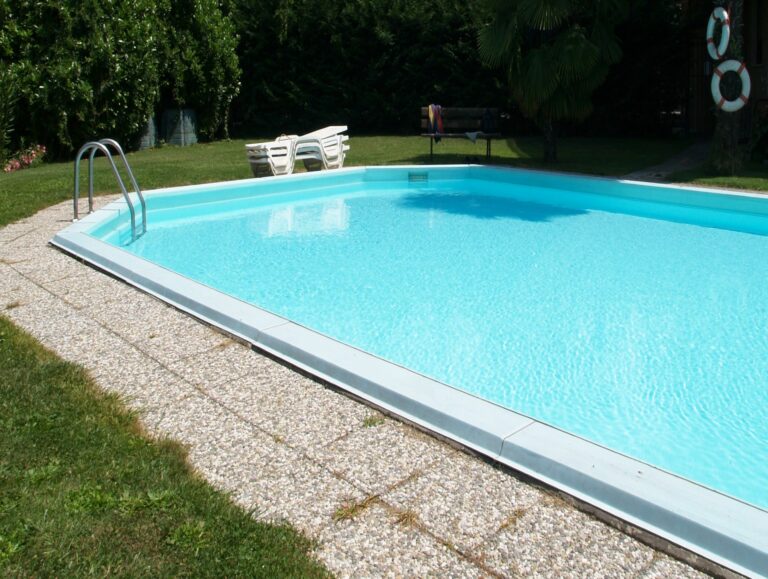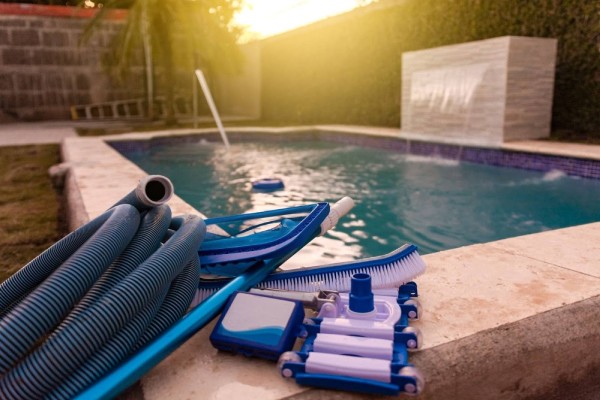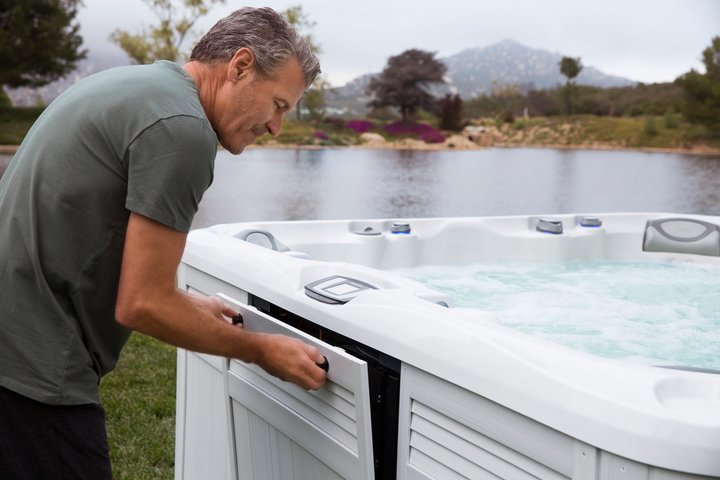It’s already getting brisk outside. This means that summer is over and it’s time to close down the pool.
Don’t just sling a cover over your pool and leave it for the season. It’s important to properly winterize the pool and protect it with a durable covering. This will prevent your equipment from being damaged by frost, ice, and frigid temperatures.
Pipes can explode and equipment can crack. Repairing the damage will cost much more than preventing it.
The water itself needs to be treated. Otherwise, algae, mildew, and bacteria will grow and spread through the water. Lime and scum can also build up and be extremely difficult to remove.
Winterization can be a chore but it’s necessary to keep your pool in good working order and preserve your investment. Fortunately, you can use your hot tub all winter long. Yes, your spa can and should be used right throughout winter.
It’s much better for the system if it’s kept running in cold weather. And some snowy outdoor spa time is amazing for your health.
Here’s a guide on how to prepare your swimming pool and hot tub for winter, followed by a few tips for backyard preparation.
How to Close and Winterize Your Swimming Pool
Step 1
Clear the pool first by removing any accessories and toys. This includes the diving board with its bolts, ladders, steps, and skimmer baskets.
Clean these off, let them dry, and store them.
Step 2
Clean the pool itself of debris and scum. Remove any debris with a skimmer and clean the side walls and bottom with a brush. You can use a pool vacuum for a thorough clean. Backwash and clean the filter using a filter cleaner.
Step 3
Test the water’s chemical levels and adjust them appropriately. Make sure the levels are balanced for your system.
Then, lower the water level to sit below where your pool cover will be. If your cover is mesh, leave the water around a foot below it. For a solid skimmer cover, lower the water to half a foot below.
Step 4
Shock and algaecide the pool. This is when you add a high dose of chemicals to kill algae, bacteria, and neutralize particulate pollutants.
Shock the poll first, then algaecide it. These processes need to be done separately.
Both will require you to spread the chemicals evenly across the pool, then circulate the water for anywhere from 4-24 hours.
Always refer to the chemical manufacturer’s directions or call and ask maintenance professionals for clarification.
Step 5
Drain, winterize and store the pool equipment. Turn the equipment off, remove the drain plugs, then remove it. Make sure you get all the filters, pumps, hoses, heater, and chlorinator.
You can seal the pool lines with expansion plugs. Let the equipment dry and store it indoors.
Step 6
Finally, cover the pool itself. Add your skimmer cover first, inflate an air pillow and place it in the center, then top this off with a durable cover. Use a safety winter cover that has secure, tight-fitting clips.
Make sure you have a good pool cover that fits properly. Go with a cover that is intended to work in your climate.
If you are reusing one from a previous season, check it for any holes, wear and tear, or damage.
How to Close Down Your Hot Tub for Winter Storage
Storing your hot tub for the winter takes a lot more work than using it. The spa will need to be drained, cleaned, checked for damage, and correctly stored.
If it isn’t properly winterized, there’ll be a lot of damage to repair in the spring.
Step 1
Shut down your hot tub completely and make sure no power is running through. Turn off the spa heater if it’s still on, turn off the hot tub itself, then turn off the circuit breaker on your home panel.
Step 2
Prepare the spa for draining. Test the water and see what the sanitizer and any other chemical levels are. Let the hot tub sit with the lid open until the levels have dropped to zero.
Then remove the cover, take the filter cartridge out of its canister, and put it away.
Step 3
Drain the tub either with a garden hose or a submersible pump. To use a garden hose, take the cap off the exterior drain spout, attach the hose, then open the spigot.
If you’d rather use a sump pump, you can immerse it in the water or attach it to the drain.
Step 4
Drain the blowers. If your tub has an air channel-blower system, you’ll need to drain it next. Re-cover the hot tub and turn the power back on. If the circuit breaker was turned off, turn it back on first, then plug the spa in.
Make sure the heater is still off. Then, turn on the hot tub itself and activate the blowers with the jets wide open to flush the lines.
Next, take the cover off again, turn off the tub, unplug it, and shut the circuit breaker down again.
Step 5
Winterize the fittings, pump, and heater. Loosen all the hot tub’s fittings, remove the drain plugs, and loosen the unions on the spa’s heater and pump. Let these lines drain completely.
Step 6
Take the filters out. Throw the filters out if they’re extremely dirty. If they are still usable, clean them in a chemical bath and then store them for later use.
Then dry up any water left inside the filter cavity.
Step 7
Blow out the jet piping lines with an air compressor. Everything needs to be done: the unions, jets, drains, and filter well. Do this twice, for at least 15 seconds each time. Any water left will freeze and can crack your hot tub.
Step 8
Remove any remaining water pooled in the spa. You can use a sump pump or wet-dry vacuum to make this easier.
Step 9
Clean the hot tub’s shell using a hot tub cleaner or diluted vinegar and baking soda. Wipe it with a gentle, non-abrasive sponge or cloth. You can apply diluted bleach to areas that have built-up scum or grime.
Step 10
Clean the hot tub cover using a hot tub cover cleaner. Look for one that has UV protectant in it. Let it dry, then replace it securely.
Take your time while you do these steps. Any water left behind has the potential to crack and damage your hot tub.
As you winterize, keep an eye out for any issues or repairs that may need to be made. You can always hire someone to winterize your hot tub for you.
How to Winter-Proof Your Hot Tub for Cold Weather Use
Step 1
Drain and refill the tub before the weather turns freezing. This will prevent you from having to flush the tub in the dead of winter when the cold can quickly freeze the lines.
Step 2
Put the hot tub into no-freeze mode. This is the setting that will keep your spa continuously warm and prevent any areas from freezing. It runs on very little power, only a few dollars per month.
Step 3
Cover the water with a floating thermal blanket. A certain amount of heat will evaporate from your spa. Thermal foam blankets can keep up to 95% of this in.
Step 4
Cover the hot tub with a high-quality cover that fits your tub well. Make sure yours can withstand the amount of snow your area gets. If you’re in an area with heavy snow, get a 6-inch hot tub cover.
A 5-inch cover will suffice for moderate snowfall. And a 4-inch one is fine for areas with light or no snowfall.
Replace your cover if it’s saturated with water. A water-saturated cover will be difficult or impossible to remove when it freezes.
Step 5
Get a hot tub cover cap. This is a light, but tough woven polyurethane cover that usually has an elastic hem. You can easily slip this over your spa cover. It protects the cover from debris, water, ice, or snow damage.
Step 6
Don’t let snow or ice pile up on or around your winter spa. Clear the cover with a long-handled soft bristle broom before too much accumulates.
Step 7
Get a small space heater or work light, in case of an extended power cut or unforeseen issue. You can tuck this into the spa’s cabinet to keep the pipes from freezing.
Step 8
Monitor your water levels, temperature, and chemicals. Adding a thermal blanket will slow down the evaporation rate but you still need to monitor it carefully.
If the water levels drop to where the spa malfunctions, you can end up with freezing pipes. Keep a close eye on things, so you can avoid any unnecessary repairs.
General Backyard Winter Preparation
Lawn
The grass needs to be mowed until it stops growing. Keep it cut to around 4 inches high. This height will protect the roots from snow and cold without being long enough for the grass itself to mat and mold.
Aerate the lawn, reseed any bare spots, and fertilize it. Use a winterizing fertilizer that’s appropriate for your grass.
Keep weeds removed, especially perennial ones like ground ivy. Use a hand tool or appropriate herbicide.
Leaves
Clean out any leaves, twigs, or debris that may have collected in the gutters and rainspouts. Some lawnmowers can collect and bag leaves.
Dispose of them through your municipality or start a composting pile. You can also mow over leaves on your lawn and let them compost where they are.
Landscaping Maintenance
Protect your landscaping by wrapping cold-sensitive shrubbery with burlap bags.
If you have thin-barked trees on your property, wrap their trunks with paper tree wrap to prevent the bark from splitting. Wrap them from 1-inch below the soil going up to the lowest branch.
Wrap shrubbery and trees with wire-mesh hardware cloth to prevent deer and other animals from eating the foliage.
Mulch your plants well before a freeze. Spreading it around the base helps stabilize the soil’s temperature and protects the plants from the elements.
To prevent plants from rotting, always keep mulch at least a couple of inches away from trunks and stems.
Keep watering your plants until the weather freezes.
Tuck Patio Furniture Away
Clean your furniture and put it away before the weather gets too cold. If you can, store your furniture away from the elements in a shed, your garage, or even under a deck.
Otherwise, use furniture covers. Always take down any patio umbrellas or swing covers and store them indoors.
Check Outdoor Lighting
Replace any bulbs that are out or wavering and look for any lighting damage. Make sure your lighting works before evenings get longer and icy weather makes it difficult to reach.
Check All Structures and Steps
Check for cracked steps, walkways, or pavement. This is dangerous to leave around. And winter will only exacerbate the damage.
You can power wash summer’s dirt away before winter gets the chance to set it further in.
Stock up on salt, concrete-friendly sand, and magnesium chloride before you need it.
Get Your Pool or Hot Tub Winterized Today
Hopefully, this information was helpful to you. There are many little steps to take to properly clean, drain, and winterize the plumbing systems in pools and hot tubs.
Don’t slack off here. It’s better to overdo your winter prep than to end up with expensive repair bills in spring.
Set some time apart, make a checklist, gather everything you need, and get through it in good time. Or call us in to take care of your maintenance for you.
You can find more resources for maintaining your recreational equipment in our owner center. This includes model-specific guides, brochures, FAQs, and helpful videos with step-by-step instructions.
If you have any questions, reach out to our pool and spa experts for help.





